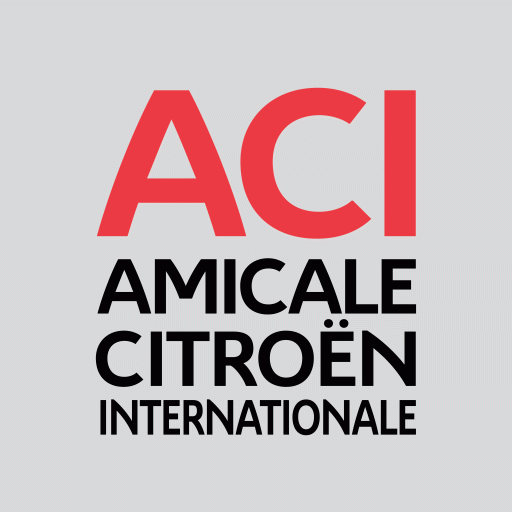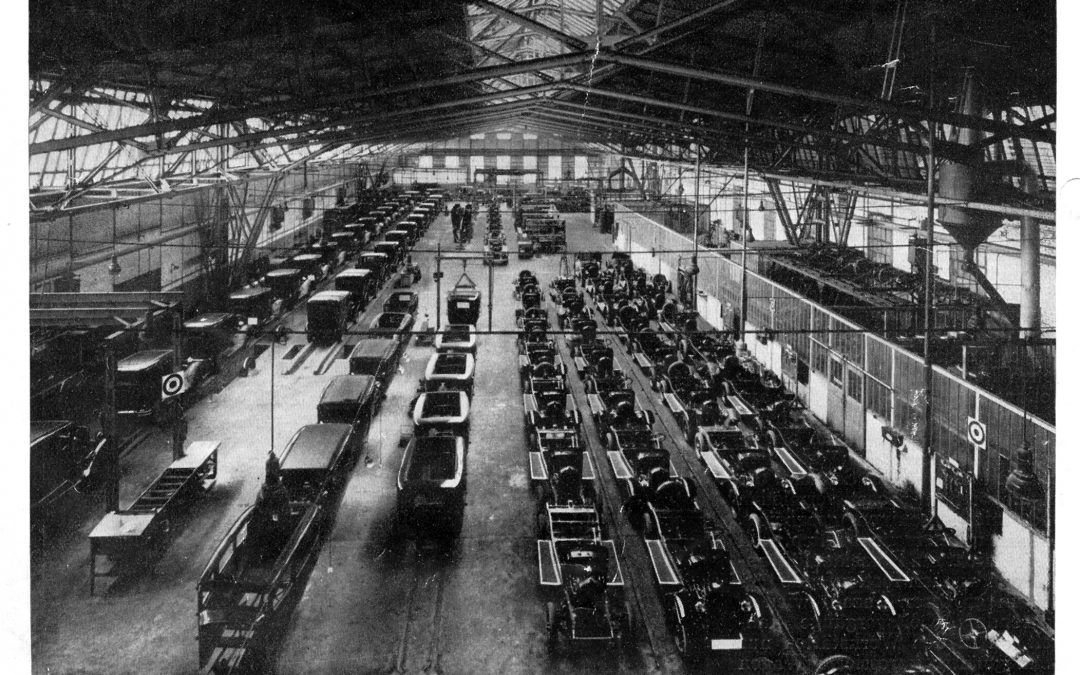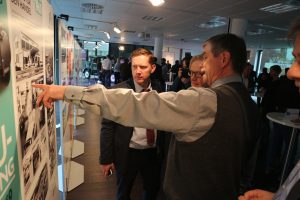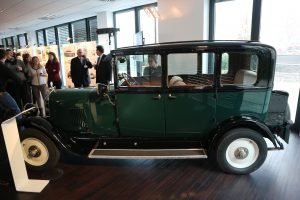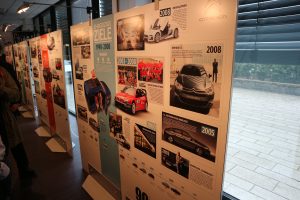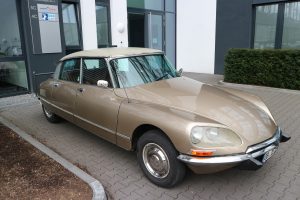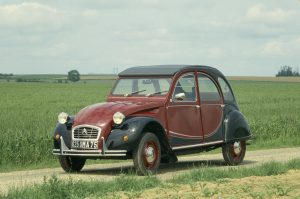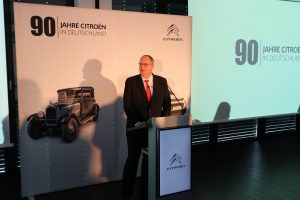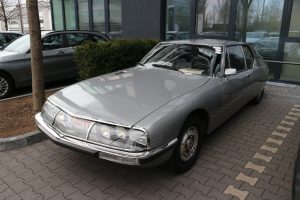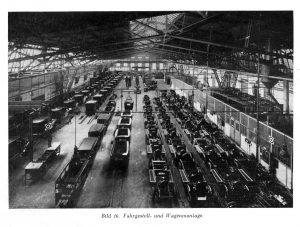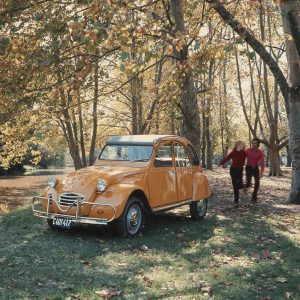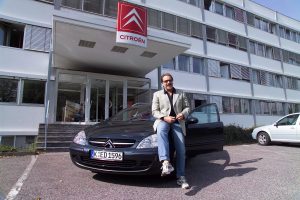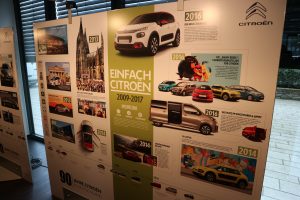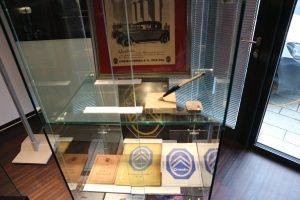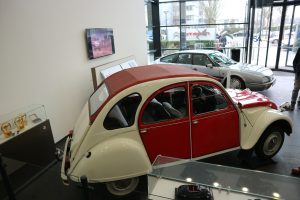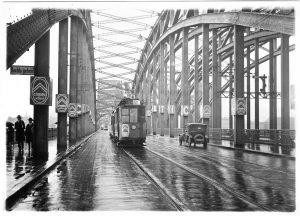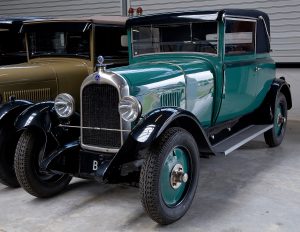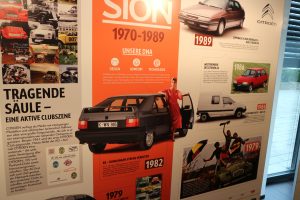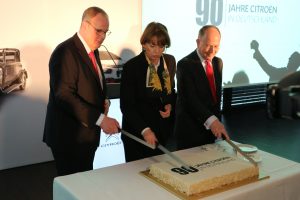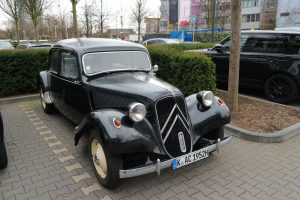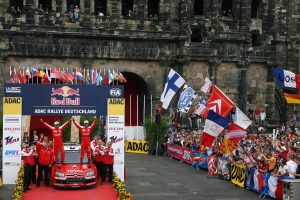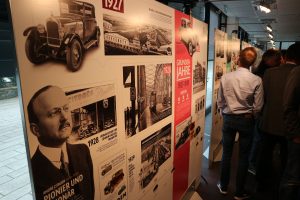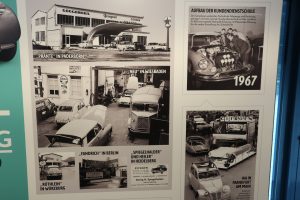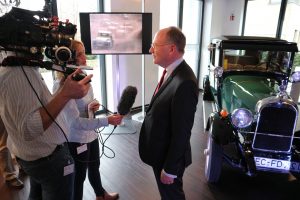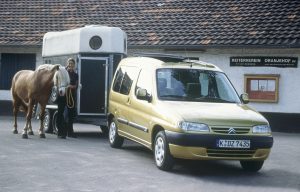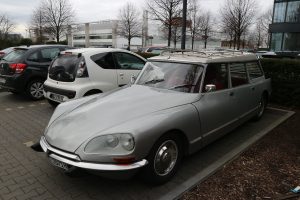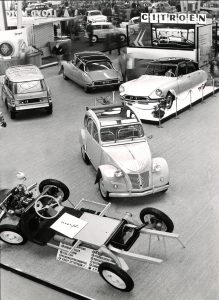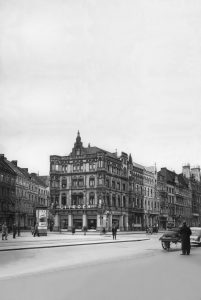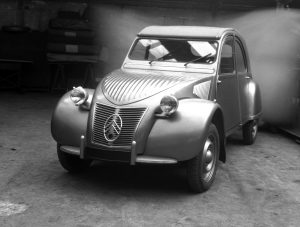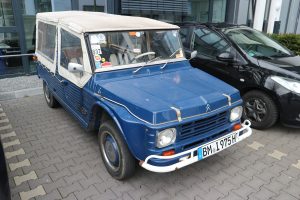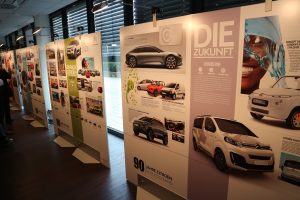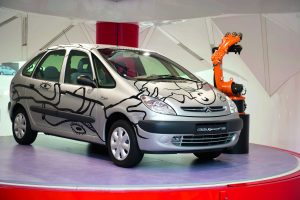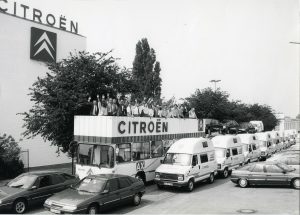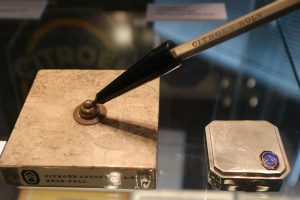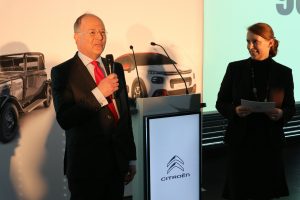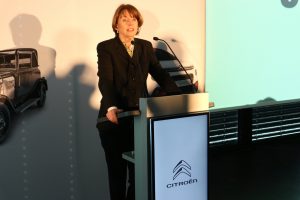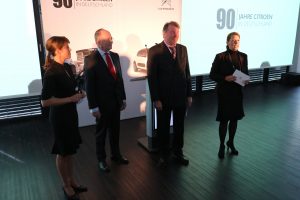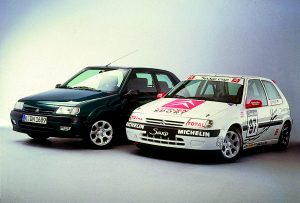To commemorate the 90th anniversary of Citroën’s official presence in Germany, a special exhibition was opened at the German headquarters of the PSA group in Cologne. The exhibition can be seen in public for the first time during the “Techno Classica”, one of Europe’s leading classic car shows, in Essen, Germany, in the first week of April and will then be on tour throughout the Federal Republic of Germany all year.
The first Citroën vehicles were already sold in Germany as early as 1923, when the first dealership opened at the “Hohenzollernring” in Cologne, but it wasn’t until 15 February, 1927 that an official Citroën subsidiary was registered at the Chamber of Commerce in Cologne. The “Citroën-Automobil Aktiengesellschaft” had been filed under registration number 6379.
With its history of nine decades, Citroën is the car company that has had the longest presence in Cologne, as the mayor of the city, Henriette Reker, pointed out in the speech that she delivered at the PSA headquarters during the opening of the exhibition to commemorate the 90th anniversary of Citroën in Germany. She also expressed her appreciation of the fact that the PSA group chose Cologne for its German headquarters when the activities of the national importers for Citroën and Peugeot were amalgamated a few years ago. Likewise, the mayor acknowledged the modern views that the company’s founder, André Citroën, had during his days as an entrepreneur, paying wages to his staff that were well above the industry average, providing kindergardens for the offspring of his employees and producing cars in price ranges that were accessible to various income groups. “He was an entrepreneur who was well aware of his social responsibilities,” the lady mayor emphasized.
Henri-Jacques Citroën, the grandson of the company’s founder, attended the opening of the exhibition, his first official function since he was appointed as an Ambassador of the Amicale Citroën Internationale (ACI) in February 2017. He was visibly impressed: “It is nice to see how my grandfather’s heritage is being preserved and kept alive here” he said. “90 years surely is a long time, especially in a relationship, like there is one between Germany and the Citroën brand.” Henri-Jacques Citroën pointed out that his grandfather didn’t care much about driving himself. “Photos of him driving his own cars are rare. He would usually have either have a chauffeur drive, or his wife. In this respect, he was very modern, too: he wanted to show that women didn’t have any problems in driving a car. And preferably a Citroën, of course.”
The foundation of the “Citroën Automobil-Aktiengesellschaft” in 1927 also marked the start of Citroën production activities in Germany. In April, 1927, the company already had 500 employees who built the Citroën B14. Local production enabled Citroën to avoid the high tax rates that applied to imported automobiles. Initially, the brand used the slogan “The German Citroën” for its promotional activities, but rivaling brands started a court case against this claim and won.
André Citroën was known as a pioneer in the fields of marketing and promotion and there was no lack of publicity for Citroën in Germany either. A landmark in Cologne, connecting the two parts of the city on either side of the Rhine river, the “Hohenzollern bridge” was adorned with Citroën promotion signs. Motorcades with the latest Citroën models roamed the country. Suppliers like Krupp, Bosch and Continental allowed for the Cologne-built Citroëns to be fully assembled with parts produced in Germany. In 1933, following the trend of the time, German Citroën promotion included the information “All parts German – German suppliers” (“Citroën – ganz deutsch”). In 1934, André Citroën visited his factory in Cologne at the occasion of the start of the production of the “Type 7 Front” with 1,5 litre engine. It was to be his last visit to Germany as he passed away one year later, the year in which the German Citroën production came to an end. In total, over 20.000 Citroën vehicles of the types B14, C4, C6, Rosalie and Traction Avant as well as various commercial vehicles were built in Cologne between 1927 and 1935.
Five years after the war, the “Citroën Automobil AG, Verkaufsgesellschaft für Deutschland” was entered as a sales organization in the register of the chamber of commerce in Cologne. The new company started operations in Cologne-Sülz on the left side of the Rhine. In 1959, the company moved to Porz-Westerhofen in the south of the city. From here, import business with models like the 2CV and the DS prospered: sales figures rose from 1.242 cars in 1957 to 13.500 cars in 1967. Only eight years later, just after the first oil crisis in 1975, Citroën sold over 50.000 cars in Germany for the first time. In the 1980s and 90s, the brand remained popular. In 2009, a total sales figure of 101.370 new cars marked a record that still stands. In 2013, the German importer amalgamated with Peugeot Germany and moved to new premises in Cologne-Gremberghofen, where all PSA brands now have their German head offices.
And that is where a roving exhibition was opened at the occasion of the brand’s 90th anniversary in Germany. Six panels show the company’s history in images and words, not only including photos of the model range over the course of time, but also showing various dealerships and workshops throughout the country. There is also plenty of attention for motorsport, with photos of the Citroën Saxo Cup one-make race series that ran in Germany for a few years around the turn of the millennium, the Citroën Racing Trophy in German rallying in recent years and the achievements by Sébastien Loeb in the German round of the World Rally Championship and José María López in the World Touring Car Championship at the Nürburgring in the past two years.
The car park in front of the PSA building showed many historic Citroëns: several DSs, a beautiful SM; an Ami6, a Méhari. Inside the building, a Cologne-built B14, a current C3 in Cologne’s red-and-white colours, a 2CV in the same livery and a CX from a German TV series were on display. German actor Götz George drove a CX in a popular German police TV series (“Schimanski”) and he was a Citroën brand ambassador for many years.
Representing the lively Citroën club scene in Germany, Britta Becker spoke in her function of chairwoman of the “Amicale Citroën & DS Deutschland”. The sales organization was represented by the board of the dealer association, including David Winter, managing director of the Häusler Citroën dealership from Darmstadt near Frankfurt that has been selling Citroëns since 1928. The roving exhibition “90 Years of Citroën in Germany” will be on display at the “Techno Classica”, world’s biggest classic vehicle show, in Essen at the beginning of April 2017 and then will go on tour to various dealerships throughout the country.
Text: Copyright (C) Rene de Boer, exclusively for Amicale Citroën Internationale (ACI) – thank you so much!
Photos: Copyright (C) annotated individually.
- Look, over here! For many Citroën dealers and employees, the photos triggered memories. Photo: René de Boer
- Cologne-built Citroën B14. Photo: René de Boer
- The exhibition includes six display panels. Photo: René de Boer
- Historic Citroën cars for the opening of the exhibition in front of Citroën’s German headquarters in Cologne, here a Traction Avant.. Photo: René de Boer
- The 2CV Charleston was popular in 1982.
- Wolfgang Schlimme, managing director of Citroën Germany, welcomed the guests. Photo: René de Boer
- Suitable for a French company, there were also macarons, specially made for the occasion. Photo: René de Boer
- Historic Citroën cars for the opening of the exhibition in front of Citroën’s German headquarters in Cologne, here a Traction Avant.. Photo: René de Boer
- Citroën production in Cologne-Poll. Photo: I.M. Leica / Citroën
- A Citroën 2CV in 1970 in a colour that was typical for that period. Photo: Citroën
- German actor Götz George, who became famous as a police inspector on TV (“Kommissar Schimanski”), was a Citroën brand ambassador in Germany for many years. Photo: Citroën
- The exhibition includes six display panels. Photo: René de Boer
- Some objects from the collection of corporate historian Immo Mikloweit were on display. Photo: René de Boer
- Some 500 guests attended the opening of the exhibition. Photo: René de Boer
- Historic Citroën cars for the opening of the exhibition in front of Citroën’s German headquarters in Cologne, here a Traction Avant.. Photo: René de Boer
- Not to be missed: Citroën promotion at the Hohenzollern bridge, a Cologne landmark, in 1927. Photo: Citroën
- From 1927, the Citroën B14 was produced in Cologne.. Photo: Citroën
- The exhibition includes six display panels. Photo: René de Boer
- Cake time! Citroën Germany’s managing director Wolfgang Schlimme, Henriette Reker, the mayor of Cologne and Henri-Jacques Citroën (l-r) opened the exhibition.. Photo: René de Boer
- Historic Citroën cars for the opening of the exhibition in front of Citroën’s German headquarters in Cologne, here a Traction Avant.. Photo: René de Boer
- With nine victories in the German round of the World Rally Championship between 2002 and 2012, Sébastien Loeb wrote history with Citroën. Photo: Citroën
- The exhibition includes six display panels. Photo: René de Boer
- A birthday cake to commemorate the 90th anniversary of Citroën in Germany. Photo: René de Boer
- The exhibition includes six display panels. Photo: René de Boer
- Interviews with Henri-Jacques Citroën were in great demand by the media. Photo: René de Boer
- : The Berlingo created a new market segment and has already been successful for two decades. Photo: Citroën
- Historic Citroën cars for the opening of the exhibition in front of Citroën’s German headquarters in Cologne, here a Traction Avant.. Photo: René de Boer
- 2CV and DS at the Citroën stand during the 1960 Frankfurt Motorshow. Photo: Citroën
- Citroëns were already sold at the Hohenzollernring in Cologne as early as 1923. Photo: Citroën
- The legendary 2CV also largely contributed to Citroën’s success in Germany. Photo: Citroën
- Historic Citroën cars for the opening of the exhibition in front of Citroën’s German headquarters in Cologne, here a Traction Avant.. Photo: René de Boer
- The exhibition includes six display panels. Photo: René de Boer
- The Xsara Picasso marked the start of the MPV era for Citroën. Photo: Citroën
- There were still promotional Citroën motorcades in Germany in 1990, among others with the XM and the C25. Photo: Citroën
- A pencil from Citroën’s history in Cologne. Photo: René de Boer
- Henri-Jacques Citroën, the grandson of the company’s founder and ACI Ambassador, referred to the long-time relationship between Germany and Citroën. Photo: René de Boer
- : Henriette Reker, the mayor of Cologne, pointed out that Citroën is the car company with the longest history in Cologne. Photo: René de Boer
- Talk with Amicale Citroën Germany chairwoman Britta Becker, Henri-Jacques Citroën, corporate historian Immo Mikloweit and Citroën press spokeswoman Susanne Beyreuther (l-r). Photo: René de Boer
- Around the turn of the millennium, Citroën was involved in German motorsport with the Saxo Cup. Photo: Citroën
